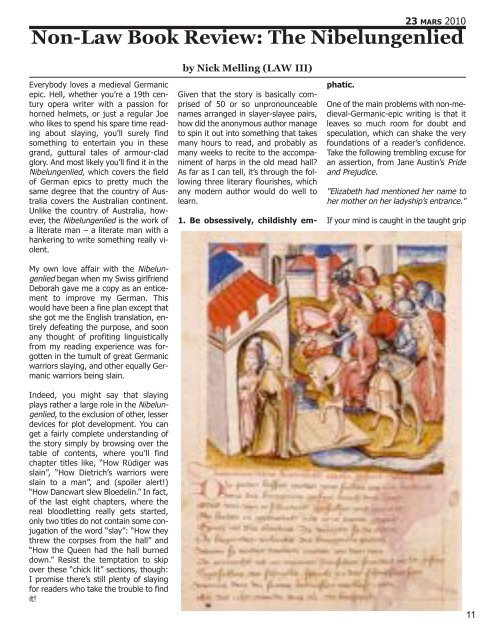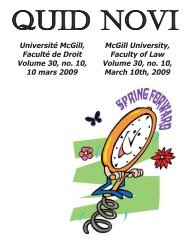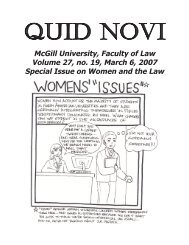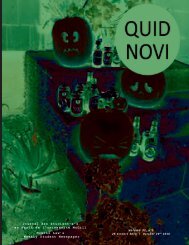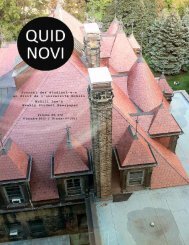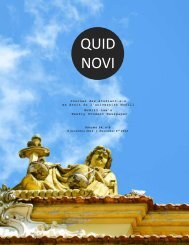March 23, 2010
March 23, 2010
March 23, 2010
You also want an ePaper? Increase the reach of your titles
YUMPU automatically turns print PDFs into web optimized ePapers that Google loves.
Non-Law Book Review: The Nibelungenlied<br />
by Nick Melling (LAW III)<br />
<strong>23</strong> MARS <strong>2010</strong><br />
Everybody loves a medieval Germanic<br />
epic. Hell, whether you’re a 19th century<br />
opera writer with a passion for<br />
horned helmets, or just a regular Joe<br />
who likes to spend his spare time reading<br />
about slaying, you’ll surely find<br />
something to entertain you in these<br />
grand, guttural tales of armour-clad<br />
glory. And most likely you’ll find it in the<br />
Nibelungenlied, which covers the field<br />
of German epics to pretty much the<br />
same degree that the country of Australia<br />
covers the Australian continent.<br />
Unlike the country of Australia, however,<br />
the Nibelungenlied is the work of<br />
a literate man – a literate man with a<br />
hankering to write something really violent.<br />
My own love affair with the Nibelungenlied<br />
began when my Swiss girlfriend<br />
Deborah gave me a copy as an enticement<br />
to improve my German. This<br />
would have been a fine plan except that<br />
she got me the English translation, entirely<br />
defeating the purpose, and soon<br />
any thought of profiting linguistically<br />
from my reading experience was forgotten<br />
in the tumult of great Germanic<br />
warriors slaying, and other equally Germanic<br />
warriors being slain.<br />
Indeed, you might say that slaying<br />
plays rather a large role in the Nibelungenlied,<br />
to the exclusion of other, lesser<br />
devices for plot development. You can<br />
get a fairly complete understanding of<br />
the story simply by browsing over the<br />
table of contents, where you’ll find<br />
chapter titles like, “How Rüdiger was<br />
slain”, “How Dietrich’s warriors were<br />
slain to a man”, and (spoiler alert!)<br />
“How Dancwart slew Bloedelin.” In fact,<br />
of the last eight chapters, where the<br />
real bloodletting really gets started,<br />
only two titles do not contain some conjugation<br />
of the word “slay”: “How they<br />
threw the corpses from the hall” and<br />
“How the Queen had the hall burned<br />
down.” Resist the temptation to skip<br />
over these “chick lit” sections, though:<br />
I promise there’s still plenty of slaying<br />
for readers who take the trouble to find<br />
it!<br />
Given that the story is basically comprised<br />
of 50 or so unpronounceable<br />
names arranged in slayer-slayee pairs,<br />
how did the anonymous author manage<br />
to spin it out into something that takes<br />
many hours to read, and probably as<br />
many weeks to recite to the accompaniment<br />
of harps in the old mead hall<br />
As far as I can tell, it’s through the following<br />
three literary flourishes, which<br />
any modern author would do well to<br />
learn.<br />
1. Be obsessively, childishly emphatic.<br />
One of the main problems with non-medieval-Germanic-epic<br />
writing is that it<br />
leaves so much room for doubt and<br />
speculation, which can shake the very<br />
foundations of a reader’s confidence.<br />
Take the following trembling excuse for<br />
an assertion, from Jane Austin’s Pride<br />
and Prejudice.<br />
"Elizabeth had mentioned her name to<br />
her mother on her ladyship’s entrance."<br />
If your mind is caught in the taught grip<br />
<br />
11


